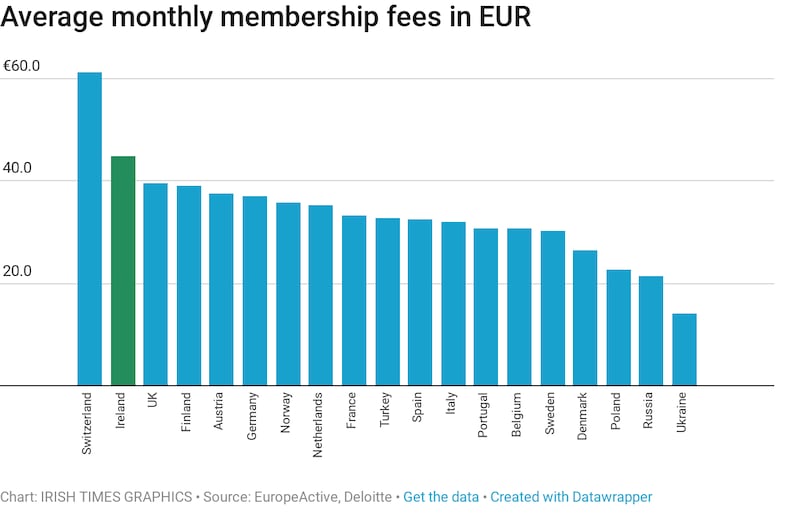On the face of it Irish people are paying up for gym membership, with rates here among the highest in Europe. But this is partly down to the structure of the sector – and also to the cost of doing business here, particularly in Dublin. The better news is that high demand is driving competition and choice: as well as traditional “leisure centre” membership, increasingly consumers can now choose low-cost models – or high-cost options involving detailed fitness training and advice. In many ways your gym bill tells us a lot about the economy. And watch out – because a key tax change in the budget might push it higher.
Gyms are big business and competition for the "sweaty euro" is on the up. A recent report by Deloitte and Europeactive estimated that 500,000 are members of Irish gyms, with total revenues just shy of €300 million. In some ways the Irish market is unusual, with many gyms being what used to be called local leisure centres, often with pools and attached to local hotels. This differs from other EU countries, where low cost operators are longer established and have a much bigger market share.
The Deloitte survey puts gym costs in Ireland at an average of €45 per month, the highest of the EU countries surveyed and second highest of the 19 countries, with only Switzerland more expensive. The cost here as a percentage of disposable income – 2.9 per cent – is the highest in the survey, where many countries are in the 2 to 2.5 per cent bracket. However the paucity, up to recent years, of low-cost operators here, compared with the dominance of this sector in many other markets, has kept average prices here high.


The relatively high cost of doing business here – and Ireland's status as a relatively high-income country – are also factors. A recent Eurostat report, the subject of an earlier Smart Money column, showed Ireland as the third most expensive country in the EU for a range of consumer items and services. In turn this relatively high price level feeds into general incomes and price levels.
Conn McCluskey, chief executive of Ireland Active, a not-for-profit body which supports the sector, argues that membership “represents excellent value for money when you take the investment in your physical and mental health, as well as giving you access to high quality facilities and services”. He points out the relatively high cost of doing business in Ireland must also be taken into account in making comparisons.
The advice to consumers is to question carefully what you are getting, what you will pay, what extra are involved and what are the cancellation terms
In many ways the gym sector is a reflection of the economy, with relatively high average price levels and now new options as growth and incomes start to rise.
What are the key changes in the sector and what do they mean for consumers? Currently, independently-owned facilities account for 80 per cent of the membership of Irish gyms, according to the Deloitte/Europeactive document. These tend to have lower membership numbers than the big chains and higher fees, pushing up the average for Ireland. However this is changing, as lower cost operators, typically charging around €25-€30 per month, expand. Brands such as Flyfit, Fit4 Less and Ben Dunne are now available in many urban centres and, looking at the European trend, this expansion can be expected to continue, along with the increase in smaller one-off low-cost operators, offering equipment and little more in retail spaces.
At the other end of the Irish market, there is also growth – again in line with international trends – in smaller, specialist operators. This will provide competition to the traditional “personal training” gyms and the traditional leisure centres and will experiment with different price points and service models. For example, one franchise chain is expanding rapidly in Dublin offering rates of around €90 per fortnight, including a range of fitness and nutritional advice services to clients.
So the Irish market, like those across Europe, is fracturing, with growth at each end, but still a much larger-than-average chunk of local leisure centre gyms in the middle ground, themselves facing increased competition and fighting to attract and hold on to clients. The other key trend internationally is the consolidation of ownership into fewer hands, with the David Lloyd chain, which has an Irish base in Clonskeagh in south Dublin, the largest operator, according to Deloitte/Europeactive. If Ireland follows EU trends, we will see more chains, more low-cost operators and increased upmarket choice as well.
The key points in understanding the economics of the sector and the costs they charge you are the following:
- Gyms are trying to come up with viable pricing models. During the recession it is no surprise that – like Aldi and Lidl – lower cost operators expanded here. The key thing for the consumer is to match this to what services and facilities are on offer. Just what are you paying for and what extras may apply?
Now that the economy is growing and incomes are on the up, Ireland is also following the other European trend to smaller, boutique, operators. These will experiment with different pricing models and service levels, but on average will cost a good deal more. There is also considerable low-level entrepreneurial activity in this area, with trainers hiring out space in gyms and halls and offering tailored services. Again these eat away at business for the established market.
The Deloitte/Europeactive survey shows how revenue per customer varies from €17 to €29 per month in the top five low cost-operators to €69 to €96 per month in the five top premium gyms.
- The popularity of gym membership, particularly among the young, means this sector will continue to grow. Typically, younger people, particularly girls, fall out of team sports in their mid-teens. But gym membership and other solo sports like running are increasingly popular. A recent Sports Ireland survey shows 27 per cent of 16-19 year old women were gym members and 21 per cent of men, with the numbers rising to 33 per cent of women and 23 per cent of men in the 20 to 24 age group. This is big business, in other words, and gyms will try to mould offerings to suit both those with little cash and a typically slightly older group with a bit more to spend. Young families remain a key target area for the mid-range leisure centre operators will pools. Often costing well over €1,000 a year, family membership is a significant cost.
– The cost of doing business in Ireland is a factor pushing up average costs here, with relatively high rents, rates, insurance levels and salaries compared to other markets. Salaries typically account for 70 per cent or more of the costs in a service business. There are no comparative figures for pay in the fitness sector. Ireland has the second highest minimum wage in Europe, one indicator of pay levels in the lower paid service industries. Average wage levels in services are in line with the euro average, though above the UK. However, Irish levels are pulled up by high pay in professional services, where salaries would be a multiple of the fitness sector.
Looking at rents, retail rental rates in Dublin City are €3,794/sqm compared with €2,163/sqm in London City (though prime West End London prices would be significantly higher) according to the recent Cost of Doing Business report from the National Competitiveness Council.
Ireland also has the second highest bank interest rates on overdrafts and business loans and relatively high insurance. All these feed into business costs.
The cost of doing business is less outside of Dublin and this tends to be reflected in lower gym membership costs. Retail rents are lower and the generally lower costs of living means less pressure to pay higher incomes to attract staff.
- VAT in Ireland is 9 per cent on gym membership, pushing up prices to consumers. However, with the 9 per cent VAT rate under threat in the budget, it is possible that the rate will revert to its former level of 13 per cent. If this remains, it will be up to gym owners whether to pass the extra cost on to members or absorb it. This would add €20-€25 per year to an average individual gym membership. The gym sector argues that this should not happen, particularly at a time when policy is to encourage people to be fit and active.
********
The bottom line is that gym membership in Ireland is, on average, not cheap, but there has been a huge expansion of choice in recent years, certainly for those living in urban areas. This should keep prices reasonably competitive.
The sector is now intensely competitive and this offers good options for many. Transparency in charges and cancellation policies – a bone of contention in the past – is also improving, through some websites give no information on either. As the sector fragments and new options emerge at different price levels, the advice to consumers is to question carefully what you are getting, what you will pay, what extras are involved and what are the cancellation terms. With a big increase in gym supply, it is not a bad time to be shopping around. And just remember, the worst value of all is for those who sign up, but only show up a handful or times – estimated by some to be as many as one in every four or five new gym recruits.
Smart Money is an online subscriber-only column by Cliff Taylor published every Thursday, looking at how economic and business trends affect your life and your pocket. Next week: how will Brexit hit your pocket. Coming soon: your rising electricity bill.












